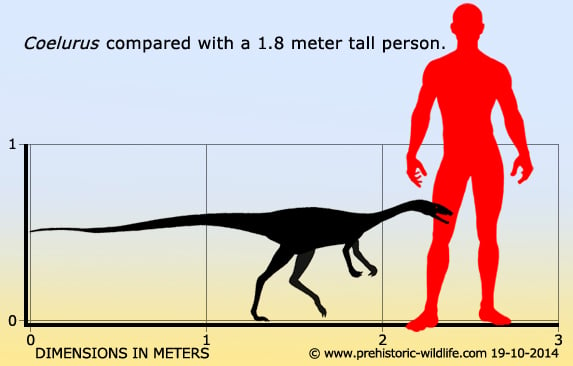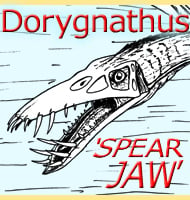In Depth
Although only a little dinosaur, the taxonomic history of Coelurus can be confusing to say the least. The first small theropod dinosaur from the famous Morrison Formation to be named, in the past the genus Coelurus has crossed paths with other small Morrison formation theropods such as Ornitholestes and Tanycolagreus. In addition to this former Coelurus species named as C. bauri and C. longicollis were re-named as being Coelophysis, a much earlier theropod dinosaur. In short the only valid species of Coelurus at the time of writing is C. fragilis. Another former species, C. agilis that was once also described as a species of Elaphrosaurus is now considered to be a synonym to C. fragilis.
Though small, Coelurus was elongated with a long neck thanks to the vertebrae that were also elongated. In addition to this general appearance, the rear legs were also very long and slender, indicating that Coelurus was both lightly built and very swift. It is likely that Coelurus was a predator of small vertebrates such as lizards and primitive mammals, but smaller ornithopod dinosaurs such as Dryosaurus and Othnielosaurus could also have been attacked, especially when sick or not yet fully grown. The speed that allowed Coelurus to be a hunter would have also been its best defence however, as larger theropod dinosaurs such as Ceratosaurus, Torvosaurus and Allosaurus are also known from the Morrison Formation, with Allosaurus being particularly common.
Despite only now being known from a partial skeleton, the hollow nature of the tail which was the inspiration for the name Coelurus, has also been used to identify an entire group of theropod dinosaurs called the Coelurosauria. The Coelurosauria today branches off to include many of the more well-known theropod groups including the alvarezsaurs, ornithomimosaurs, therizinosaurs, dromaeosaurs, and most famous of all these, the tyrannosaurs. This is a stark contrast to when the Coelurosauria was first created to only include the small theropod dinosaurs, something that it is no longer used for. However, the partial nature of the only remaining Coelurus fossils means that there are still a lot of unanswered questions concerning exactly how the Coelurus genus was related to all these others. Unfortunately our ability to answer these questions depends entirely upon future fossil discoveries being made.
Further Reading
- Notice of new Jurassic reptiles. - American Journal of Science, series 3 18: 501–505. - Othniel Charles Marsh - 1879. - The dinosaurian genus Coelurus. - American Naturalist 21: 367–369. - Edward Drinker Cope - 1887. - On a new genus of Triassic Dinosauria. - American Naturalist 23: 626. - Edward Drinker Cope - 1889. - Coelurus and Ornitholestes: Are they the same? - John H. Ostrom - In Aspects of Vertebrate History: Essays in Honor of Edwin Harris Colbert, Louis L. Jacobs (ed) - Flagstaff: Museum of Northern Arizona Press. pp. 245–256 - 1980. - A new skeleton of Coelurus fragilis from the Morrison Formation of Wyoming. - Journal of Vertebrate Paleontology 18 (3, Suppl.): 64A. - Clifford A. Miles, Kenneth Carpenter & Karen Cloward - 1998. - Redescription of the small maniraptoran theropods Ornitholestes and Coelurus from the Upper Jurassic Morrison Formation of Wyoming - Kenneth Carpenter, Clifford Miles, John H. Ostrom & Karen Cloward - In The Carnivorous Dinosaurs, Kenneth Carpenter (ed).- Bloomington: Indiana University Press. pp. 49–71 - 2005.










